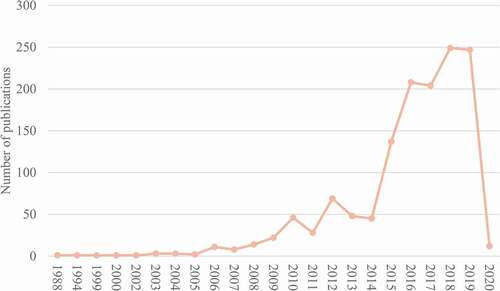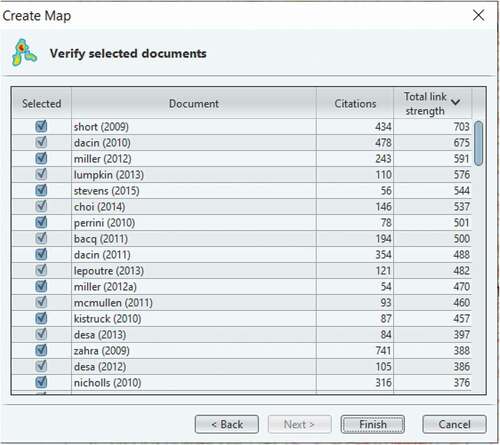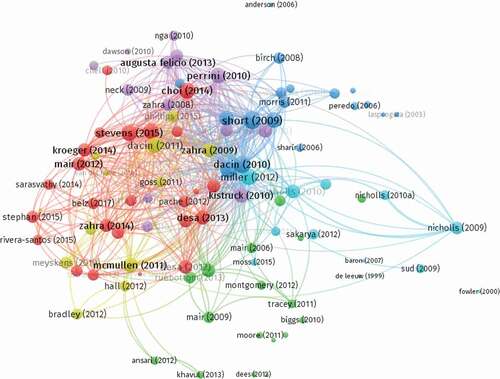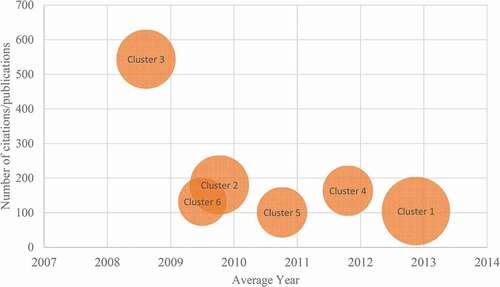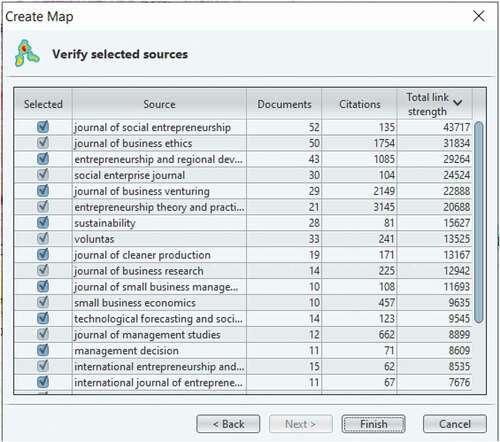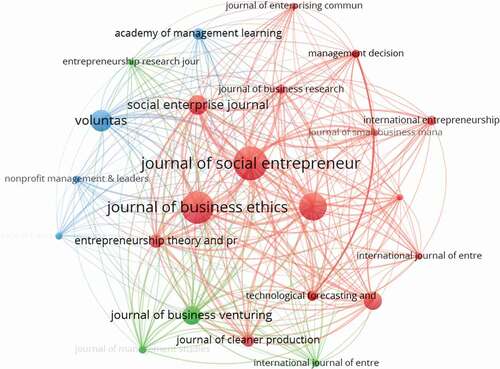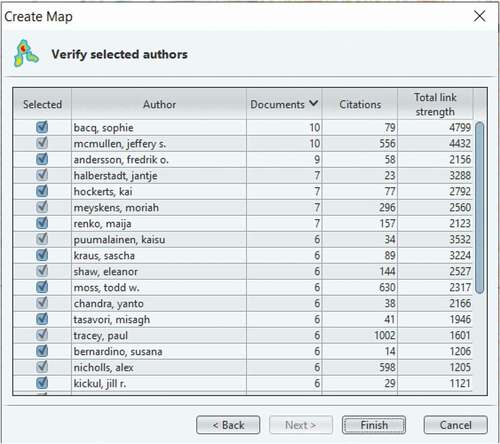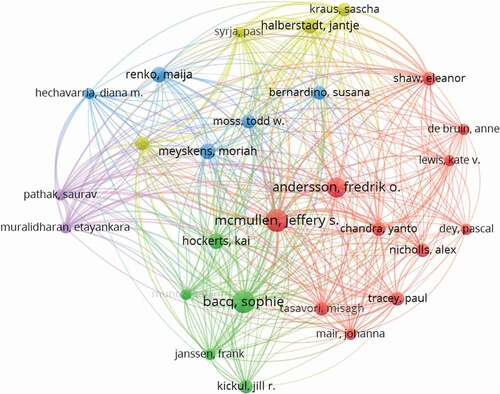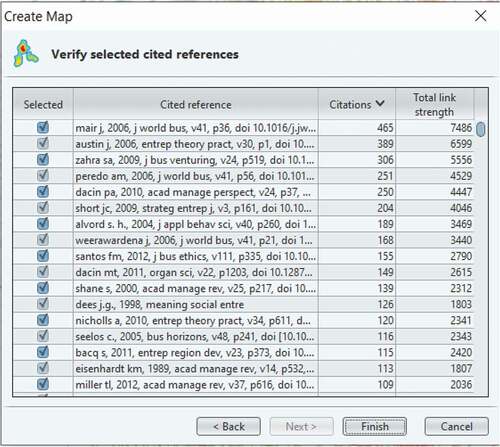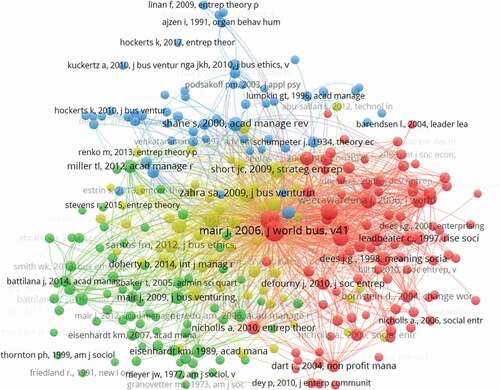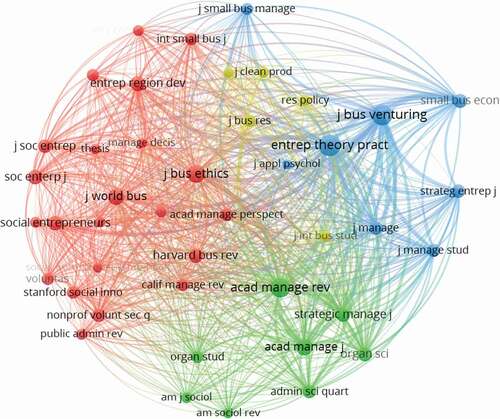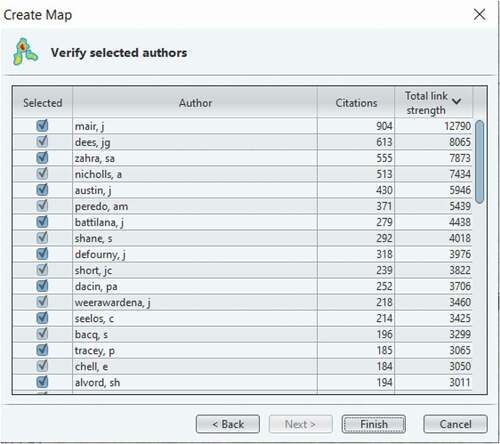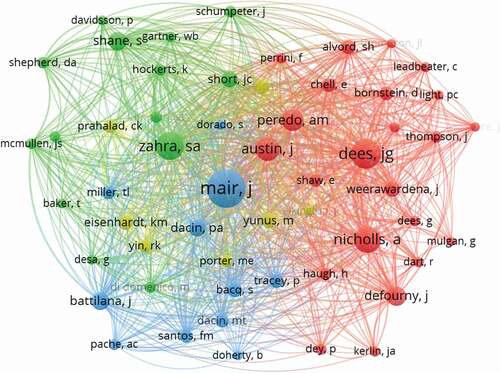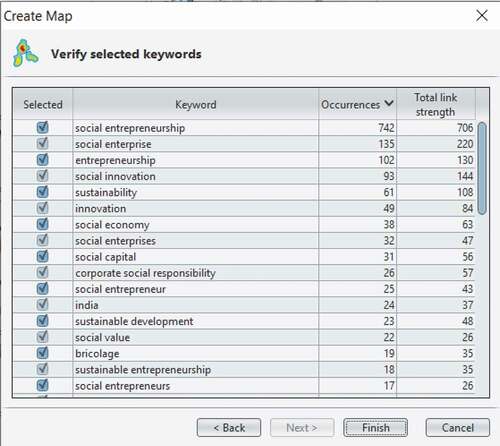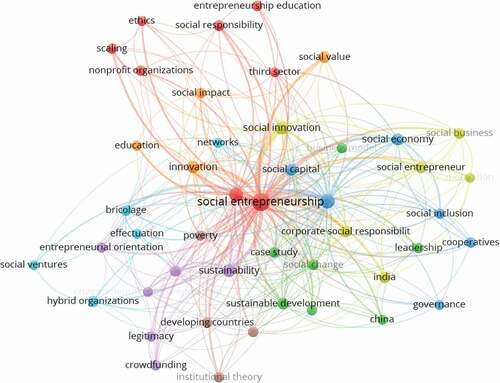Abstract
In recent years, social entrepreneurship has received an increasing attention from the academic community. Social entrepreneurship is a topic related to various areas such as economics, management, education, sociology, psychology, and it is not surprising that issues related to social entrepreneurship are always debated with various definitions, methods, and approaches. This study aims to establish networks and maps in social entrepreneurship based on a systematic review of 1361 publications from the Web of Science database. More specifically, three methods of bibliographic analysis, namely bibliographic coupling, co-citation and co-word analyses are used to explore publication rankings and the main clusters by each method, the most influential publications, authors, journals, and keywords are therefore identified. The results from this study help researchers locate their research, discover potential themes for future research, and make social entrepreneurship knowledge more accessible to new researchers and policymakers.
PUBLIC INTEREST STATEMENT
In the past decade, the concept of social entrepreneurship has witnessed noticeable academic-attention and become a major and influential literature. In this study, author subsequently intend to fill the void of literature, which is in ways not fully explored to date yet, via utilizing and further combining three distinct bibliometric methods, namely co-citation, bibliographic coupling, and co-word, to complementarity capture and connect the bibliographic information to rigorously and holistically explore the constantly changed social entrepreneurship subject and renew our knowledge. The results can provide a global view and guidelines of social entrepreneurship literature so that the academia can acknowledge current contributions, locate research resources in potential areas, and explore subsequent future research in this field.
1. Introduction
Over the years, social entrepreneurship has received great cognition (Saebi et al., Citation2019). Despite its emergence in the 1950s (Bowen, Citation1953), in the past decade, the concept of social entrepreneurship has been witnessed a noticeable academic-attention and become a major and influential literature (Saebi et al., Citation2019). Supporting the government to address social issues and creating social value are the main traits that distinguish social entrepreneurship from its commercial counterpart (Abu-Saifan, Citation2012; Akar & Dogan, Citation2018; Alegre et al., Citation2017). Social entrepreneurship is contended a solution that solves a quantity of complex and diverse social issues including women empowerment (Datta & Gailey, Citation2012), poverty (Seelos & Mair, Citation2005; Smith & Stevens, Citation2010), social change and transformation (Alvord et al., Citation2004); (Perrini et al., Citation2010; Sarkar, Citation2018), social justice (Phipps & Prieto, Citation2018), etc. These indicate that social entrepreneurship is a topic related to various fields such as economics, management, education, sociology, and psychology, thereby not surprisingly issues related to social entrepreneurship have been explored from several disciplines which utilize and apply various definitions, methods, approaches, and theories to elucidate and justify social phenomena (Kroeger & Weber, Citation2014; M.T. Dacin et al., Citation2011; Santos, Citation2012).
The considerable growth of proliferated social entrepreneurship literature from diverse disciplines has accumulated our knowledge, whereas the limit to the expertise in individual studies warrants a call for a scholarship to comprehensively review and synthesize existing works to provide a general picture of literature. As such, a number of synthetic reviews have been conducted while the majority are qualitative and subjective in nature. The limited minority have applied bibliometric techniques to quantitatively and objectively review existing literature to take stock of or visualize where we are. Among others, Granados et al. (Citation2011), Persaud et al. (Citation2018), and Rey-Marti et al. (Citation2016) apply a citation approach to simply reveal the performance of individual articles, authors, journals, etc., from the most active and influential perspective. Dionisio (Citation2019), in a further attempt, utilizes a co-citation analysis to classify science base clusters, thus mapping the knowledge structure of social entrepreneurship. However, another two methods, bibliographic coupling and co-word analysis, are neglected, while these methods, supplementary to the functions provided by citation and co-citation, are potential to optimally map research fronts and thus identifying emerging fields and filtering smaller subfields, and categorize the conceptual structure of the domain.
Different bibliometric methods entail their own strengths and weakness. Combining various methods with their supplementary roles to create a comprehensive literature map thereby providing better results and facilitating deeper understandings has thus become a trend in the bibliometric landscape (Chang et al., Citation2015). In this study, author subsequently intend to fill the void of literature, which is in ways not fully explored to date yet, via utilizing and further combining three distinct bibliometric methods, namely co-citation, bibliographic coupling, and co-word, to complementarily capture and connect the bibliographic information to rigorously and holistically explore the constantly changed social entrepreneurship subject and renew our knowledge. In such a sense, this study aims to identify up-to-date important works, establish mapping and networks in social entrepreneurship literature, visualize main clusters from each method, and contrast them with those forwarded in prior synthetic reviews. Hence, the most leading and influential authors, publications, journals, and keywords in a longitudinal way will be filtered and revealed; intellectual foundations, knowledge structures, and typologies and frameworks specific to the studied matter will be uncovered and captured; thus, insight into the dynamics of subject development, the emerging issues, and the evolution and trend will be generated and identified, which can renew and advance our social entrepreneurship knowledge and facilitate its continued development. Such devoted efforts and study results can provide a global view and guidelines of social entrepreneurship literature so that the academia can acknowledge current contributions, locate research resources in potential areas, and explore subsequent future research in this field. In addition, policymakers will easily access scholarly knowledge about social entrepreneurship and apply it in practice.
This paper starts with a brief overview of the field of social entrepreneurship and the description of the three methods of bibliographic analyses, including co-citation, bibliographic coupling, and co-word analysis. The following parts present methodological procedures and then the results of the analysis. The conclusions, the avenues for future research, and the limitation comprise the final sections of this paper.
2. Social entrepreneurship: a brief overview
The concept of social entrepreneurship emerged in 1953 (Bowen, Citation1953). Another seminal contribution to the field of social entrepreneurship is a short descriptive paper of Waddock and Post (Citation1991). In the academic world, the term “social entrepreneurship“ appeared in the late 1990s in the US (Boschee, Citation1995; Dees & Dees, Citation1998) and in the UK (Leadbeater, Citation1997). Boschee (Citation1995) defines social entrepreneurship as non-profit actions that balance moral imperatives and the profit motives. Dees and Dees (Citation1998) define that it is a combination of passion for solving social problems and business activities. Leadbeater (Citation1997) describes social entrepreneurship as a large array of non-profit activities in many areas such as economics, education, research, welfare and social activities.
More recently, the definition of social business has increased significantly. Some scholars consider it as a process that includes the creative use of resources to explore and exploit opportunities, in order to catalyze social changes by serving human fundamental needs that aim towards sustainable development (Mair & Noboa, Citation2006; Marti & Mair, Citation2006). Others argue that social entrepreneurship includes the concept of “construction, evaluation and pursuit of opportunities”, which aim to create social values primarily instead of economic values (Austin et al., Citation2006). For Nicholls Nicholls (Citation2008), social entrepreneurship is a set of creative and effective activities, focusing strategically on addressing social market failures and creating new opportunities for systematic increase in social value. Simply put, social entrepreneurship is determined by two constituent factors: the strategic focus is the social impact and the creative approach to achieve its mission. Nicholls (Citation2010) notes that no definitive consensus on what the term social entrepreneurship actually means. Choi and Majumdar (Citation2014) also agree with Nicholls (Citation2010) that social entrepreneurship is a fundamentally disputed concept, which explains why it is difficult to find a common definition of commune entrepreneurship and explain why it suggests different meanings between different parties.
Many excellent reviews have been conducted (Bacq & Janssen, Citation2011; M.T. Dacin et al., Citation2011; Peredo & McLean, Citation2006; Phillips et al., Citation2015). However, due to the widely dispersed social entrepreneurship field and the number of social entrepreneurship studies is very large and growing incessantly. With the increasing number of studies on social entrepreneurship, this study aims to provide an updated bibliographic analysis of research topics and identify the most influential authors, journals, articles, and keywords.
3. Bibliometric analysis and methodological procedures
The term “bibliometric” is defined as “the application of mathematical and statistical methods to books and the other means of communication” (Van Eck & Waltman, Citation2009). Broadus (Citation1987) defines bibliometric as “the quantitative study of physical published units, or of bibliographic units, or of the surrogates for either”. Bibliometric is an approach to assess and monitor the development of a research topic by organizing and linking the basic information of publications, such as citations, authors, co-author, journals, and keywords (Ferreira, Citation2018; Koseoglu et al., Citation2016). Bibliometric analysis includes different methods, for instance, bibliographic coupling, co-citation analysis, and co-word analysis (Van Eck & Waltman, Citation2009).
Both bibliographic coupling and co-citation use citation analysis to establish a similarity between publications. The bibliographic coupling strength of the two measured publications is defined as the number of items these two publications share in their reference lists (Kessler, Citation1963). In other words, bibliographic coupling occurs when two publications reference a common third publication in their bibliographies. In another way, co-citation is defined as the frequency with which two publications are cited together by other publications (Small, Citation1973). Co-citation occurs when two publications (i.e., A and B) are cited by publication C, showing the relationship of co-citation between publications A and publications B. The more co-citations two publications receives, the higher their co-citation strength and the more likely they are related to each other (Ferreira, Citation2018). Co-word analysis is based on the assumption that each field of study can be characterized by a list of keywords and the keywords in each publication can be measured for similarity in order to show a relationship between those two publications (De La Hoz-correa et al., Citation2018). Co-word analysis is a content analysis technique that uses patterns of co-occurrence of pairs of keywords to determine the relationship between the topic ideas presented in these documents (Leung et al., Citation2017).
4. Method
All publications (e.g., articles, books, editorial material, book chapters, notes, and letters) related to social entrepreneurship were searched in Web of Science (WoS) database. The phrase “social entrepreneur*” was searched in the title/abstract/keyword field in selected databases. The scope of this study is restricted before 16 January 2020. The initial search resulted in 1670 publications. Of these, 309 were excluded from the analysis because they were duplicate or covered topics that were not related to social entrepreneurship. As a result, a total of 1361 publications were retrieved for the final analysis. provides annual trends in the number of published publications from 1999 to 2020 (January). The number of social entrepreneurship publications has increased sharply since 2009. The annual publication average came in at 17 February, highlighting that social entrepreneurship is increasingly receiving much attention from the academic community.
Bibliographic coupling, co-citation and co-word analyses were used to analyze 1361 publications related to social entrepreneurship. Particularly, bibliographic coupling analysis was presented to show (1) the most influential publications of bibliographic coupling analysis and bibliographic coupling network of publications; (2) bibliographic coupling analysis cluster and representative publications for each cluster; (3) the most influential journals of bibliographic coupling analysis and bibliographic coupling network of journals; and (4) authorship and bibliographic coupling network of authors. In addition, co-citation analysis was presented to show (1) the most influential publications of co-citation analysis and co-citation network of publications; (2) co-citation analysis cluster and representative publications for each cluster; (3) the most influential journals of co-citation analysis and co-citation network of journals; (4) the most influential authors and co-citation network of authors. Finally, co-word analysis was performed to identify (1) the most influential keyword in social entrepreneurship; (2) visualized co-word network in social entrepreneurship
For each of the above analysis techniques, scientific maps were used to visualize the structure of the theoretical basis of the research topic (Cobo et al., Citation2011). Networks were built and visualized for social entrepreneurship research by VOSviewer software (Van Eck & Waltman, Citation2009; Waltman, Citation2017). In order to reveal the structure of social entrepreneurship research, the smart local moving (SLM) algorithm method was used to cluster citations (Van Eck & Waltman, Citation2009). The size of the bubble represented the number of standardized citations that the articles received and the thickness of the lines denoted the strength of citation relations. The link and the distance between two publications demonstrated the relationship strength. The color of the bubble indicated the cluster in which the document belonged to.
5. Bibliographic coupling analysis
5.1. Publications
In order to better explore the structure of a research topic, McCain (Citation1990) proposes to establish a cut-off point to select the most influential publications. Therefore, from 1361 publications, the authors narrowed down by selecting only those publications that had at least 50 citations. Correspondingly, this study analyzed 98 pubications in bibliographic coupling analysis. shows the most influential publications of bibliographic coupling analysis.
Following , the five studies with the highest total link strength:
1. Short, J. C., Moss, T. W., & Lumpkin, G. T. (2009). Research in Social entrepreneurship: past contributions and future opportunities. Strategic entrepreneurship journal, 3(2), 161–194.
2. Dacin, P. A., Dacin, M. T., & Matear, M. (2010). Social entrepreneurship: Why we don’t need a new theory and how we move forward from here. Academy of management perspectives, 24(3), 37–57.
3. Miller, T. L., Wesley, C. L., & Williams, D. E. (2012). Educating the minds of caring hearts: comparing the views of practitioners and educators on the importance of social entrepreneurship competencies. Academy of management learning & education, 11(3), 349–370.
4. Lumpkin, G., Moss, T. W., Gras, D. M., Kato, S., & Amezcua, A. S. (2013). Entrepreneurial processes in social contexts: how are they different, if at all? Small business economics, 40(3), 761–783.
5. Stephan, U., Uhlaner, L. M., & Stride, C. (2015). Institutions and social entrepreneurship: the role of institutional voids, institutional support, and institutional configurations. Journal of international business studies, 46(3), 308–331.
Bibliographic coupling network was presented in . Bibliographic coupling network formed six clusters. The clusters and representative publications are presented in .
Table 1. Bibliographic coupling cluster and representative publications for each cluster
Results from the bibliographic coupling clusters showed that the publications in the first cluster accounted for the most with 24 publications (2522 citations) while the third cluster had the highest number of citations with 9788 citations, averaging 543 citations/publication.
Longitudinal analysis was used to analyze clusters through number of citations/paper and the average year (). The clusters could be considered as the most influential or potential research clusters depending on their location on the map. The clusters at the top were more likely to be the most influential research clusters, while the clusters at the right were more likely to become potential research clusters. Accordingly, revealed that publications in the third cluster had a great influence in social entrepreneurship literature and the publications in the first and the fourth cluster were likely to become new research lines in the near future.
5.2. Journal
In order to discover which journals that these publications belonged to, journals with at least 10 publications were analyzed. The final sample comprises 23 journals (). The top five journals were Journal of Social Entrepreneurship (52 publications), Journal of Business Ethics (50 publications), Entrepreneurship and Regional Development (43 publications), VOLUNTAS: International Journal of Voluntary and Nonprofit Organizations (33 publications), Social Enterprise Journal (30 publications), Journal of Business Venturing (29 publications), Sustainability (28 publications) and Entrepreneurship Theory and Practice (21 publications).
presents the bibliographic coupling network of journals. As can be noted, the journals were analyzed into 3 clusters. The first cluster had 15 journals, which was composed of top journals such as Journal of Social Entrepreneurship, Entrepreneurship Theory and Practice, Social Enterprise Journal, Sustainability, Entrepreneurship and Regional Development. The second and third cluster had four journals each. The top journals featured in cluster 2 included Journal of Business Venturing, the International Journal of Entrepreneurship and Innovation, and in cluster 3 included VOLUNTAS, Nonprofit and Voluntary Sector Quarterly.
5.3. Authors
Regarding the authors, the results showed that 2786 authors were responsible for 1361 articles included in the sample. This research narrowed down the number of authors responsible for at least five publications, thus only 27 authors were remained. Top three authors were Sophie Bacq (Kelley School of Business at Indiana University), Jeffery S. McMullen (Kelley School of Business at Indiana University), and Fredrik O. Andersson (O’Neill School of Public and Environmental Affairs at Indiana University). shows the authors with the highest number of publications.
In order to complement the bibliographic coupling of the authors, the network was shown in . The bibliographic coupling of the authors formed five clusters. There was a group of primary authors with high indices of bibliographic coupling of 11 authors (red cluster). The remaining clusters have the number of authors from two to five. Some typical authors represented each cluster as Johanna Mair, Eleanor Shaw, McMullen Jeffery (cluster 1), Sophie Bacq, Kai Hockerts (cluster 2), Moriah Meyskens, Maija Renko (Cluster 3), Jantje Halberstadt, Sascha Kraus (cluster 4), Etayankara Muralidharan, Saurav Pathak (Cluster 5).
Regarding the author’s institution, bibliographic coupling results highlighted that the universities with the highest number of social entrepreneurship studies were Indiana University (US), University of Valencia (Spain), University of Oxford (UK), University of Illinois (US), Copenhagen Business School (Denmark), University of Essex (UK), University of Cambridge (UK), Northwestern University (US), University of St. Gallen (Switzerland), Harvard University (US). These were the top universities in the world and had a strong interest in social entrepreneurship studies. In particular, most of these universities were in the UK or the US, the leading countries in term of social enterprises development.
6. Co-citation analysis
Similar to the bibliographic coupling analysis, the co-citation analysis was used to identify the most influential publications, journals, authors, and their clusters and networks.
6.1. Publications
A cut point was established to select the most influential publications (McCain, Citation1990). Therefore, from 1361 original publications were responsible for 49,703 citations. In order to narrowed down these 49,703 citations, authors selected a threshold by which the minimum number of citations of a cited reference was at least 20. The final sample included 271 publications. shows the most cited publications.
Following , the five studies with highest indices of co-citation are
1. Mair, J., & Marti, I. (2006). Social entrepreneurship research: A source of explanation, prediction, and delight. Journal of world business, 41(1), 36–44.
2. Austin, J., Stevenson, H., & Wei-Skillern, J. (2006). Social and commercial entrepreneurship: Same, different, or both? Entrepreneurship Theory and Practice, 30(1), 1–22.
3. Zahra, S. A., Gedajlovic, E., Neubaum, D. O., & Shulman, J. M. (2009). A typology of social entrepreneurs: Motives, search processes and ethical challenges. Journal of business venturing, 24(5), 519–532
4. Peredo, A. M., & McLean, M. (2006). Social entrepreneurship: A critical review of the concept. Journal of world business, 41(1), 56–65.
5. Dacin, P. A., Dacin, M. T., & Matear, M. (2010). Social Entrepreneurship: Why we don’t need a new theory and how we move forward from here. Academy of management perspectives, 24(3), 37–57.
Co-citation network was presented in . Co-citation network formed four clusters. The clusters and representative publications are presented in . These clusters were named based on a majority of references in that cluster. The first cluster was the concept development of social entrepreneurship and social enterprise, focusing on different approaches to increase the understanding of social entrepreneurship and social enterprises. The second cluster referred to issues related to management in social entrepreneurship such as education, institutional context, empowerment, hybrid organization. The third cluster presented opportunity recognition and social entrepreneurial intention. The studies of social entrepreneurial models were also included in this cluster. These models are inherited from entrepreneurial models and modifications to match the social entrepreneurship context. The fourth cluster was mainly comprised of the reviews of social entrepreneurship studies and social entrepreneurs.
Table 2. Co-citation analysis cluster and representative publications for each cluster
6.2. Journals
A total of 43 journals analyzed with at least 200 citations were presented with a co-citation network map. shows the most influential journals in the social entrepreneurship. The top journals of co-citation analysis show the influential and prerequisite journals for the development of social entrepreneurship include Entrepreneurship Theory and Practice, Academy of Management Review, Journal of Business Venturing, Journal of Business Ethics, Academy of Management Journal.
When comparing these results with those from bibliographic coupling of journals, it was clear that some journals such as Entrepreneurship Theory and Practice, Journal of Business Venturing and Journal of Business Ethics continuously influence and lead social entrepreneurship research. The disappearance of the Academy of Management Review and the Academy of Management Journal in the top journal list of bibliographic coupling analysis was considered to be evident with the appearance of social entrepreneurship professional journal such as Journal of Social Entrepreneurship, Entrepreneurship and Regional Development, and VOLUNTAS: International Journal of Voluntary and Nonprofit Organizations, and Social Enterprise Journal.
Four clusters of journals were formed and sorted by color shown in . Most journals in the first cluster belonged to entrepreneurship field, for examples Journal of Business Ethics, Journal of Social Entrepreneurship, Entrepreneurship and Regional Development, and VOLUNTAS: International Journal of Voluntary. Meanwhile, the other clusters covered journals of more general topics such as management (Academy of Management Journal, Academy of Management Review), strategy (Strategic Management Journal, Strategic Entrepreneurship Journal).
6.3. Authors
For authorship, authors have at least 100 citations shown in . The authors with the highest number of citations are Johanna Mair (Hertie School of Governance, Germany), J. Gregory Dees, Shaker A. Zahra (University of Minnesota, USA), Alex Nicholls (University of Oxford, UK), James E. Austin (Harvard Business School, USA). Some authors such as Alex Nicholls (University of Oxford, UK), Bacq (Kelley School of Business at Indiana University), Eleanor Shaw (University of Strathclyde), and Kai Hockerts (Copenhagen Business School) appeared in both bibliographic coupling and co-citation analysis. This indicated the continuous impact and high-ranking level of these authors. The co-citation network of authors was presented in .
The co-citation cluster of authors showed that the first cluster included the most influential authors. This group of authors focused on developing social entrepreneurship concepts, specifically clarifying the differences between social entrepreneurship and commercial entrepreneurs. Meanwhile, the other author clusters focused on different issues such as social enterprises, social entrepreneurs, intention to start a social business, innovation, social change, and bricolage resource mobilization.
7. Co-word analysis
A total of 2882 keywords were generated from 1361 publications. The authors narrowed down and removed keywords that appeared less than 10 times. As a result, only 50 keywords were retained for co-word analysis ().
Some keywords showed issues that were getting an increasing attention in social entrepreneurship research such as “ethics”, “nonprofit organizations”, “scaling”, “social responsibility” (cluster 1), “business model”, “leadership”, “social change”, “sustainable development” (cluster 2), “social capital”, “social enterprise”, “social economy” (cluster 3), “social entrepreneur”, “motivation”, “social innovation”, “corporate social responsibility” (cluster 4), “orientation”, “crowd funding”, “sustainability”, “sustainable entrepreneurship” (cluster 5), “bricolage”, “hybrid organizations” (cluster 6), “education”, “social impact” and “social value” (cluster 7), “developing countries”, “institutions”, “institutional theory” (cluster 8) (see ).
Some research directions can be derived from focusing on keywords such as scaling social entrepreneurship, business model in social entrepreneurship, motivation and orientation of potential social entrepreneurs, strategies to develop social entrepreneurship towards sustainable development, measurement of social values, social change and social impact in social entrepreneurship, new types of social entrepreneurship organizations such as hybrid organizations, bricolage in social entrepreneurship and impact of institution to social entrepreneurship.
8. Conclusions and avenues for future research
Social entrepreneurship is increasingly recognized as a long-term solution to reconcile financial interests and social values. There are theoretical and practical reasons explaining why a deeper understanding of social entrepreneurship is important (Chell et al., Citation2016). Thus, the interest of the scholars for social entrepreneurship has significantly increased over the past decade. Although some excellent reviews have been conducted (Bacq & Janssen, Citation2011; M.T. Dacin et al., Citation2011; Peredo & McLean, Citation2006; Phillips et al., Citation2015), discoveries about the updated scientific structure of social entrepreneurship are still limited (Rey-Marti et al., Citation2016).
In order to gain a comprehensive scientific structure that helps predict future research directions in the field of social entrepreneurship, a holistic map on this topic needs to be done. This study carries out a bibliometric analysis of research related to social entrepreneurship to explore the scientific structures and relationships between the fundamental publications in this field through bibliographic analyses. More specifically, three methods of bibliometric analysis including bibliographic coupling, co-citation, and co-word analyses are combined to provide an overview of the intellectual structure of this promising research themes, thus allow researchers to locate their research in this area and explore new research directions in the future. Results from bibliographic coupling analysis show publications with the highest indices of bibliographic coupling are Short et al. (Citation2009), P. A. Dacin et al. (Citation2010), Miller et al. (Citation2012), Lumpkin et al. (Citation2013), and Stephan et al. (Citation2015) while studies with highest indices of co-citation are Marti and Mair (Citation2006), Austin et al. (Citation2006), Zahra et al. (Citation2009), Peredo and McLean (Citation2006), and P. A. Dacin et al. (Citation2010)). Some authors such as Alex Nicholls (University of Oxford, UK) and Bacq (Kelley School of Business at Indiana University), Eleanor Shaw (University of Strathclyde), Kai Hockerts (Copenhagen Business School) appear in both bibliographic coupling analysis and co-citation analysis. This indicates that the top ranking and continuously leading positions of these authors. The journals that are both influential in the early stages of social entrepreneurship and still lead current research on social entrepreneurship including Entrepreneurship Theory and Practice, Journal of Business Venturing, Journal of Business Ethics. Besides, there is an emerging trend that entrepreneurship professional journals such as Journal of Social Entrepreneurship, Entrepreneurship and Regional Development, and VOLUNTAS: International Journal of Voluntary and Nonprofit Organizations, Social Enterprise Journal become a home for social entrepreneurship research. Results of keyword analysis show some suggestions for future research directions such as measurement scales of social entrepreneurship associated concepts, applicability of business models in social entrepreneurship, motivations and orientations of potential social entrepreneurs, strategies to develop social entrepreneurship towards sustainable development, evaluation of social values, social changes and social impacts of social entrepreneurship, new types of social entrepreneurship organizations such as hybrid organizations, bricolage in social entrepreneurship and impact of institutions on social entrepreneurship.
The social entrepreneurship knowledge provided in this study is expected to encourage new scholars to participate in this emerging field. In addition, the results from bibliographic analysis help researchers position their current research as well as identify new research directions in the future. Finally, the scientific structure of social entrepreneurship from this research can provide policymakers an easy access to academic knowledge and overall picture of social entrepreneurship that can be applied into practices. This is the first study to combine bibliographic coupling, co-citation and co-word analyses to the analysis of existing publications related to social entrepreneurship. Therefore, it is impossible without restrictions. Firstly, this research uses the data sources from WoS. Future studies may use wider data sources to ensure that available studies are not missed. Secondly, keywords can be categorized and used by other analytical techniques such as correspondence analysis to get further insight and discover new trends in social entrepreneurship through keywords. Finally, the review based on the number of citations in long time period cannot reveal the influential role of recently emerging studies. Thus, dividing study time period into sub-periods can be helpful in discovering the changes and evolution of leading research themes over time in social entrepreneurship.
Additional information
Notes on contributors
Luc Phan Tan
Dr Luc Phan Tan is a lecturer of Thu Dau Mot University, Binh Duong Province, Vietnam. His research focuses on entrepreneurship, social entrepreneurship, sustainability entrepreneurship and corporate social responsibility.
References
- Abu-Saifan, S. (2012). Social entrepreneurship: Definition and boundaries. Technology Innovation Management Review, 2(2), 22–27. https://doi.org/https://doi.org/10.22215/timreview/523
- Ajzen, I. (1991). The theory of planned behavior. Organizational Behavior and Human Decision Processes,50(2), 179–21. https://doi.org/https://doi.org/10.1016/0749-5978(91)90020-T
- Akar, H., & Dogan, Y. B. (2018). The role of personal values in social entrepreneurship. Universal Journal of Educational Research, 6(1), 83–90. https://doi.org/https://doi.org/10.13189/ujer.2018.060107
- Alegre, I., Kislenko, S., & Berbegal-Mirabent, J. (2017). Organized Chaos: Mapping the definitions of social entrepreneurship. Journal of Social Entrepreneurship, 8(2), 248–264. https://doi.org/https://doi.org/10.1080/19420676.2017.1371631
- Alvord, S. H., Brown, L. D., & Letts, C. W. (2004). Social entrepreneurship and societal transformation: An exploratory study. The Journal of Applied Behavioral Science, 40(3), 260–282. https://doi.org/https://doi.org/10.1177/0021886304266847
- Austin, J., Stevenson, H., & Wei-Skillern, J. (2006). Social and commercial entrepreneurship: Same, different, or both? Entrepreneurship Theory and Practice, 30(1), 1–22. https://doi.org/https://doi.org/10.1111/j.1540-6520.2006.00107.x
- Bacq, S., & Janssen, F. (2011). The multiple faces of social entrepreneurship: A review of definitional issues based on geographical and thematic criteria. Entrepreneurship and Regional Development, 23(5–6), 373–403. https://doi.org/https://doi.org/10.1080/08985626.2011.577242
- Battilana, J., & Dorado, S. (2010). Building sustainable hybrid organizations: The case of commercial microfinance organizations. Academy of Management Journal,53(6), 1419–1440. https://doi.org/https://doi.org/10.5465/AMJ.2010.57318391
- Boschee, J. (1995). Some nonprofits are not only thinking about the unthinkable, they’re doing it—running a profit. Across the Board, the Conference Board Magazine,32(3), 20–25
- Bowen, H. R. (1953). The social responsibilities of the businessman. Harper.
- Broadus, R. (1987). Toward a definition of “bibliometrics”. Scientometrics, 12(5–6), 373–379. https://doi.org/https://doi.org/10.1007/BF02016680
- Certo, S. T., & Miller, T. (2008). Social entrepreneurship: Key issues and concepts. Business Horizons,51(4), 267–271. https://doi.org/https://doi.org/10.1016/j.bushor.2008.02.009
- Chang, Y.-W., Huang, M.-H., & Lin, C.-W. (2015). Evolution of research subjects in library and information science based on keyword, bibliographical coupling, and co-citation analyses. Scientometrics, 105(3), 2071–2087. https://doi.org/https://doi.org/10.1007/s11192-015-1762-8
- Chell, E. (2007). Social enterprise and entrepreneurship: towards a convergent theory of the entrepreneurial process. International Small Business Journal,25(1), 5–26. https://doi.org/https://doi.org/10.1177/0266242607071779
- Chell, E., Spence, L. J., Perrini, F., & Harris, J. D. (2016). Social entrepreneurship and business ethics: Does social equal ethical? Journal of Business Ethics, 133(4), 619–625. https://doi.org/https://doi.org/10.1007/s10551-014-2439-6
- Choi, N., & Majumdar, S. (2014). Social entrepreneurship as an essentially contested concept: Opening a new avenue for systematic future research. Journal of Business Venturing, 29(3), 363–376. https://doi.org/https://doi.org/10.1016/j.jbusvent.2013.05.001
- Cobo, M. J., López-Herrera, A. G., Herrera-Viedma, E., & Herrera, F. (2011). An approach for detecting, quantifying, and visualizing the evolution of a research field: A practical application to the fuzzy sets theory field. Journal of Informetrics, 5(1), 146–166. https://doi.org/https://doi.org/10.1016/j.joi.2010.10.002
- Corner, P. D., & Ho, M. (2010). How opportunities develop in social entrepreneurship. Entrepreneurship Theory and Practice,34(4), 635–659.
- Dacin, M. T., Dacin, P. A., & Tracey, P. (2011). Social entrepreneurship: A critique and future directions. Organization Science, 22(5), 1203–1213. https://doi.org/https://doi.org/10.1287/orsc.1100.0620
- Dacin, P. A., Dacin, M. T., & Matear, M. (2010). Social entrepreneurship: Why we don’t need a new theory and how we move forward from here. Academy of Management Perspectives, 24(3), 37–57. https://doi.org/https://doi.org/10.5465/amp.2010.52842950
- Datta, P. B., & Gailey, R. (2012). Empowering women through social entrepreneurship: Case study of a women’s cooperative in India. Entrepreneurship Theory and Practice, 36(3), 569–587. https://doi.org/https://doi.org/10.1111/j.1540-6520.2012.00505.x
- Davidsson, P., & Honig, B. (2003). The role of social and human capital among nascent entrepreneurs. Journal of Business Venturing,18(3), 301–331. https://doi.org/https://doi.org/10.1016/S0883-9026(02)00097-6.
- De La Hoz-correa, A., Muñoz-Leiva, F., & Bakucz, M. (2018). Past themes and future trends in medical tourism research: A co-word analysis. Tourism Management, 65(1), 200–211. https://doi.org/https://doi.org/10.1016/j.tourman.2017.10.001
- Dees, Dees, J. G. (1998). Enterprising nonprofits. Harvard Business Review, 76(1), 54–69.
- Dees, J. G. (2007). Taking social entrepreneurship seriously. Society,44(3), 24–31. https://doi.org/https://doi.org/10.1007/bf02819936
- Dees, J. G. (2012). A Tale of Two Cultures: Charity, Problem Solving, and the Future of Social Entrepreneurship. Journal of Business Ethics,111(3), 321–334. https://doi.org/https://doi.org/10.1007/s10551-012-1412-5
- Desa, G. (2012). Resource Mobilization in International Social Entrepreneurship: Bricolage as a Mechanism of Institutional Transformation. Entrepreneurship Theory and Practice,36(4), 727–751. https://doi.org/https://doi.org/10.1111/j.1540-6520.2010.00430.x
- Desa, G., & Basu, S. (2013). Optimization or Bricolage? Overcoming Resource Constraints in Global Social Entrepreneurship. Strategic Entrepreneurship Journal,7(1), 26–49. https://doi.org/https://doi.org/10.1002/sej.1150
- Di Domenico, M., Haugh, H., & Tracey, P. (2010). Social Bricolage: Theorizing Social Value Creation in Social Enterprises. Entrepreneurship Theory and Practice,34(4), 681–703. https://doi.org/https://doi.org/10.1002/sej.1150
- Dionisio, M. (2019). The evolution of social entrepreneurship research: A bibliometric analysis. Social Enterprise Journal, 15(1), 22–45. https://doi.org/https://doi.org/10.1108/sej-05-2018-0042
- Dorado, S., & Ventresca, M. J. (2013). Crescive entrepreneurship in complex social problems: Institutional conditions for entrepreneurial engagement. Journal of Business Venturing,28(1), 69–82.https://doi.org/https://doi.org/10.1016/j.jbusvent.2012.02.002
- Eisenhardt, K. M. (1989). Building theories from case study research. Academy of Management Review,14(4), 532–550. https://doi.org/https://doi.org/10.2307/258557
- Felício, J. A., Gonçalves, H. M., & da Conceição Gonçalves, V. (2013). Social value and organizational performance in non-profit social organizations: Social entrepreneurship, leadership, and socioeconomic context effects. Journal of Business Research,66(10), 2139–2146.
- Ferreira, F. A. (2018). Mapping the field of arts-based management: Bibliographic coupling and co-citation analyses. Journal of Business Research, 85(1), 348–357. https://doi.org/https://doi.org/10.1016/j.jbusres.2017.03.026
- Granados, M. L., Hlupic, V., Coakes, E., & Mohamed, S. (2011). Social enterprise and social entrepreneurship research and theory. Social Enterprise Journal, 7(3), 198–218. https://doi.org/https://doi.org/10.1108/17508611111182368
- Harris, J. D., Sapienza, H. J., & Bowie, N. E. (2009). Ethics and entrepreneurship. Journal of Business Venturing,24(5), 407–418. https://doi.org/https://doi.org/10.1016/j.jbusvent.2009.06.001
- Hockerts, K. (2010). Social entrepreneurship between market and mission. International Review of Entrepreneurship,8(2), 177–198. Available at SSRN: https://ssrn.com/abstract=2696915.
- Hockerts, K. (2017). Determinants of social entrepreneurial intentions. Entrepreneurship Theory and Practice, 41(1), 105–130. https://doi.org/https://doi.org/10.1111/etap.12171
- Kessler, M. M. (1963). Bibliographic coupling between scientific papers. American Documentation, 14(1), 10–25. https://doi.org/https://doi.org/10.1002/asi.5090140103
- Kistruck, G. M., & Beamish, P. W. (2010). The Interplay of Form, Structure, and Embeddedness in Social Intrapreneurship. Entrepreneurship Theory and Practice,34(4), 735–761. https://doi.org/https://doi.org/10.1111/j.1540-6520.2010.00371.x
- Koseoglu, M. A., Rahimi, R., Okumus, F., & Liu, J. (2016). Bibliometric studies in tourism. Annals of Tourism Research, 61(1), 180–198. https://doi.org/https://doi.org/10.1016/j.annals.2016.10.006
- Kroeger, A., & Weber, C. (2014). Developing a conceptual framework for comparing social value creation. Academy of Management Review, 39(4), 513–540. https://doi.org/https://doi.org/10.5465/amr.2012.0344
- Krueger Jr, N. F., Reilly, M. D., & Carsrud, A. L. (2000). Competing models of entrepreneurial intentions. Journal of Business Venturing, 15(5–6), 411–432. https://doi.org/https://doi.org/10.1016/S0883-9026(98)00033-0
- Leadbeater, C. (1997). The rise of the social entrepreneur. Demos.
- Lepoutre, J., Justo, R., Terjesen, S., & Bosma, N. (2013). Designing a global standardized methodology for measuring social entrepreneurship activity: the Global Entrepreneurship Monitor social entrepreneurship study. Small Business Economics,40(3), 693–714. https://doi.org/https://doi.org/10.1007/s11187-011-9398-4
- Leung, X. Y., Sun, J., & Bai, B. (2017). Bibliometrics of social media research: A co-citation and co-word analysis. International Journal of Hospitality Management, 66(1), 35–45. https://doi.org/https://doi.org/10.1016/j.ijhm.2017.06.012
- Liñán, F., & Chen, Y. W. (2009). Development and Cross‐Cultural application of a specific instrument to measure entrepreneurial intentions. Entrepreneurship Theory and Practice,33(3), 593–617. https://doi.org/https://doi.org/10.1111/j.1540-6520.2009.00318.x
- Lumpkin, G., Moss, T. W., Gras, D. M., Kato, S., & Amezcua, A. S. (2013). Entrepreneurial processes in social contexts: How are they different, if at all? Small Business Economics, 40(3), 761–783. https://doi.org/https://doi.org/10.1007/s11187-011-9399-3
- Mair, J., Battilana, J., & Cardenas, J. (2012). Organizing for Society: A Typology of Social Entrepreneuring Models. Journal of Business Ethics111(3), 353–373. https://doi.org/https://doi.org/10.1007/s10551-012-1414-3
- Mair, J., & Marti, I. (2009). Entrepreneurship in and around institutional voids: A case study from Bangladesh. Journal of Business Venturing,24(5), 419–435. https://doi.org/https://doi.org/10.1016/j.jbusvent.2008.04.006
- Mair, & Noboa. (2006). Social entrepreneurship: How intentions to create a social venture are formed. Palgrave Macmillan.
- Marti, I., & Mair. (2006). Social entrepreneurship research: A source of explanation, prediction, and delight. Journal of World Business, 41(1), 36–44. https://doi.org/https://doi.org/10.1016/j.jwb.2005.09.002
- McCain, K. W. (1990). Mapping authors in intellectual space: A technical overview. Journal of the American Society for Information Science, 41(6), 433–443. https://doi.org/https://doi.org/10.1002/(SICI)1097-4571(199009)41:6<433::AID-ASI11>3.0.CO;2-Q
- McMullen, J. S. (2011). Delineating the Domain of Development Entrepreneurship: A Market-Based Approach to Facilitating Inclusive Economic Growth. Entrepreneurship Theory and Practice,35(1), 185–215. https://doi.org/https://doi.org/10.1111/j.1540-6520.2010.00428.x
- Meyskens, M., Carsrud, A. L., & Cardozo, R. N. (2010). The symbiosis of entities in the social engagement network: The role of social ventures. Entrepreneurship and Regional Development,22(5), 425–455. https://doi.org/https://doi.org/10.1080/08985620903168299
- Miller, T. L., Grimes, M. G., McMullen, J. S., & Vogus, T. J. (2012). Venturing for others with heart and head: How compassion encourages social entrepreneurship. Academy of Management Review, 37(4), 616–640. https://doi.org/https://doi.org/10.5465/amr.2010.0456
- Miller, T. L., Wesley, C. L., & Williams, D. E. (2012). Educating the Minds of Caring Hearts: Comparing the Views of Practitioners and Educators on the Importance of Social Entrepreneurship Competencies. Academy of Management Learning & Education,11(3), 349–370. https://doi.org/https://doi.org/10.5465/amle.2011.0017
- Morris, M. H., Webb, J. W., & Franklin, R. J. (2011). Understanding the Manifestation of Entrepreneurial Orientation in the Nonprofit Context. Entrepreneurship Theory and Practice,35(5), 947–971. https://doi.org/https://doi.org/10.1111/j.1540-6520.2011.00453.x
- Nga, J. K. H., & Shamuganathan, G. (2010). The influence of personality traits and demographic factors on social entrepreneurship start up intentions. Journal of Business Ethics,95(2), 259–282. https://doi.org/https://doi.org/10.1007/s10551-009-0358-8
- Nicholls, A. (2008). The new social entrepreneurship: What awaits social entrepreneurship ventures? International Small Business Journal, 26(2), 247–251. https://doi.org/https://doi.org/10.1177/02662426080260020503
- Nicholls, A. (2009). 'We do good things, don't we?': 'Blended Value Accounting' in social entrepreneurship. Accounting Organizations and Society, 34(6–7), 755–769. https://doi.org/https://doi.org/10.1016/j.aos.2009.04.008
- Nicholls, A. (2010). Institutionalizing social entrepreneurship in regulatory space: Reporting and disclosure by community interest companies. Accounting Organizations and Society, 35(4), 394–415. https://doi.org/https://doi.org/10.1016/j.aos.2009.08.001
- Nicholls, A. (2010). The Legitimacy of Social Entrepreneurship: Reflexive Isomorphism in a Pre-Paradigmatic Field. Entrepreneurship Theory and Practice,34(4), 611–633. https://doi.org/https://doi.org/10.1111/j.1540-6520.2010.00397.x
- Peredo, A. M., & McLean, M. (2006). Social entrepreneurship: A critical review of the concept. Journal of World Business, 41(1), 56–65. https://doi.org/https://doi.org/10.1016/j.jwb.2005.10.007
- Perrini, F., Vurro, C., & Costanzo, L. A. (2010). A process-based view of social entrepreneurship: From opportunity identification to scaling-up social change in the case of San Patrignano. Entrepreneurship and Regional Development, 22(6), 515–534. https://doi.org/https://doi.org/10.1080/08985626.2010.488402
- Persaud, A., Bayon, M., & Cartmell, S. (2018). Social entrepreneurship research: A bibliometric analysis. Academy of Management, 2018(1), 1-40. https://doi.org/https://doi.org/10.5465/AMBPP.2018.15510abstract.
- Phillips, W., Lee, H., Ghobadian, A., O’Regan, N., & James, P. (2015). Social innovation and social entrepreneurship: A systematic review. Group & Organization Management, 40(3), 428–461. https://doi.org/https://doi.org/10.1177/1059601114560063
- Phipps, S. T. A., & Prieto, L. C. (2018). The business of black beauty: Social entrepreneurship or social injustice? Journal of Management History, 24(1), 37–56. https://doi.org/https://doi.org/10.1108/jmh-06-2017-0029
- Rey-Marti, A., Ribeiro-Soriano, D., & Palacios-Marques, D. (2016). A bibliometric analysis of social entrepreneurship. Journal of Business Research, 69(5), 1651–1655. https://doi.org/https://doi.org/10.1016/j.jbusres.2015.10.033
- Saebi, T., Foss, N. J., & Linder, S. (2019). Social entrepreneurship research: Past achievements and future promises. Journal of Management, 45(1), 70–95. https://doi.org/https://doi.org/10.1177/0149206318793196
- Santos, F. M. (2012). A positive theory of social entrepreneurship. Journal of Business Ethics, 111(3), 335–351. https://doi.org/https://doi.org/10.1007/s10551-012-1413-4
- Sarkar, S. (2018). Grassroots entrepreneurs and social change at the bottom of the pyramid: The role of bricolage. Entrepreneurship and Regional Development, 30(3–4), 421–449. https://doi.org/https://doi.org/10.1080/08985626.2017.1413773
- Seelos, C., & Mair, J. (2005). Social entrepreneurship: Creating new business models to serve the poor. Business Horizons, 48(3), 241–246. https://doi.org/https://doi.org/10.1016/j.bushor.2004.11.006
- Shane, S., & Venkataraman, S. (2000). The promise of entrepreneurship as a field of research. Academy of Management Review,25(1), 217–226. https://doi.org/https://doi.org/10.2307/259271.
- Sharir, M., & Lerner, M. (2006). Gauging the success of social ventures initiated by individual social entrepreneurs. Journal of World Business,41(1), 6–20. https://doi.org/https://doi.org/10.1016/j.jwb.2005.09.004
- Shaw, E., & Carter, S. (2007). Social entrepreneurship: Theoretical antecedents and empirical analysis of entrepreneurial processes and outcomes. Journal of Small Business and Enterprise Development,14(3), 418–434. https://doi.org/https://doi.org/10.1108/14626000710773529
- Short, J. C., Moss, T. W., & Lumpkin, G. T. (2009). Research in social entrepreneurship: Past contributions and future opportunities. Strategic Entrepreneurship Journal, 3(2), 161–194. https://doi.org/https://doi.org/10.1002/sej.69
- Small, H. (1973). Co-citation in the scientific literature: A new measure of the relationship between two documents. Journal of the American Society for Information Science, 24(4), 265–269. https://doi.org/https://doi.org/10.1002/asi.4630240406
- Smith, B. R., & Stevens, C. E. (2010). Different types of social entrepreneurship: The role of geography and embeddedness on the measurement and scaling of social value. Entrepreneurship and Regional Development, 22(6), 575–598. https://doi.org/https://doi.org/10.1080/08985626.2010.488405
- Stephan, U., Uhlaner, L. M., & Stride, C. (2015). Institutions and social entrepreneurship: The role of institutional voids, institutional support, and institutional configurations. Journal of International Business Studies, 46(3), 308–331. https://doi.org/https://doi.org/10.1057/jibs.2014.38
- Tracey, P., Phillips, N., & Jarvis, O. (2011). Bridging Institutional Entrepreneurship and the Creation of New Organizational Forms: A Multilevel Model. Organization Science,22(1), 60–80. https://doi.org/https://doi.org/10.1287/orsc.1090.0522
- Van Eck, N., & Waltman, L. (2009). Software survey: VOSviewer, a computer program for bibliometric mapping. Scientometrics, 84(2), 523–538. https://doi.org/https://doi.org/10.1007/s11192-009-0146-3
- Waddock, S. A., & Post, J. E. (1991). Social entrepreneurs and catalytic change. Public Administration Review, 51(5), 393–401. https://doi.org/https://doi.org/10.2307/976408
- Waltman, L. (2017). Citation-based clustering of publications using CitNetExplorer and VOSviewer. Scientometrics, 111(2), 1053–1070. https://doi.org/https://doi.org/10.1007/s11192-017-2300-7
- Weerawardena, J., & Mort, G. S. (2006). Investigating social entrepreneurship: A multidimensional model. Journal of World Business,41(1), 21–35. https://doi.org/https://doi.org/10.1016/j.jwb.2005.09.001.
- Zahra, S. A., Gedajlovic, E., Neubaum, D. O., & Shulman, J. M. (2009). A typology of social entrepreneurs: Motives, search processes and ethical challenges. Journal of Business Venturing, 24(5), 519–532. https://doi.org/https://doi.org/10.1016/j.jbusvent.2008.04.007
- Zahra, S. A., Rawhouser, H. N., Bhawe, N., Neubaum, D. O., & Hayton, J. C. (2008). Globalization of social entrepreneurship opportunities. Strategic entrepreneurship journal,2(2), 117–131. https://doi.org/https://doi.org/10.1002/sej.43

